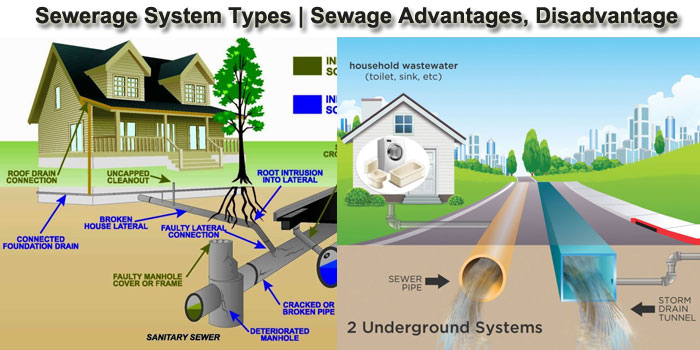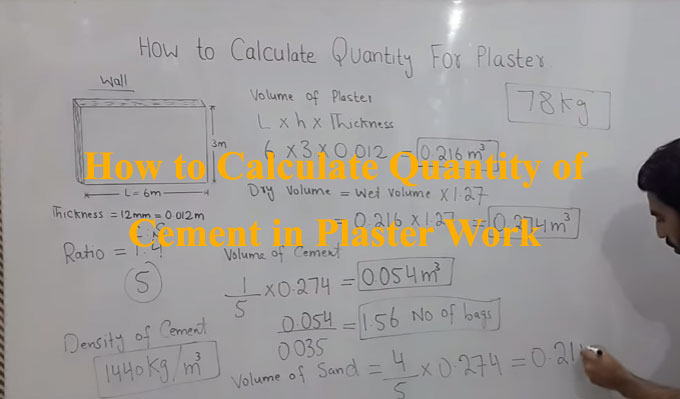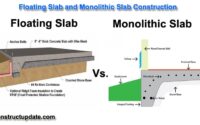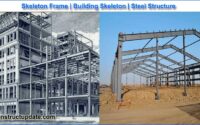Sewerage System Types | Sewage Advantages, Disadvantage | Waste Management Systems
Sewerage System
A sewerage system, also known as a wastewater collection system, is a system of pipes, pumping stations, and other devices that transport sewage from its source to a treatment and disposal facility.
Types of Sewerage System
1. Separate System:
Two sets of sewers are provided in this system: one for domestic or sanitary sewage and industrial sewage, and the other for stormwater (or rainwater).
Sewage from the first set of sewers is transported to a treatment plant, whereas stormwater (or rain water) from the second set of sewers is dumped straight into a natural stream or river without treatment.
Separate System Advantages:
(i) Because the amount of sewage to be treated is modest, fewer treatment plants will be required, and the burden on the treatment units will be reduced.
(ii) Because storm water (or rain water) is not overly polluted, it can be dumped directly into a natural stream or river without treatment.
(iii) If pumping is necessary for sewage lifting at the treatment plant, the system will be cost-effective both in terms of capital and operating costs.
(iv) The sewers are cost-effective due to their tiny size. Additional storm water (or rain water) could be conveyed through open or closed drains at or near the ground surface, lowering the cost of system installation.
Separate System Disadvantages:
(i) Because the sewers are small, cleaning them is challenging.
(ii) The sewers will most likely become clogged.
(iii) In the absence of a steep gradient, self-cleaning velocity in the sewers cannot be guaranteed, necessitating flushing. This could be disappointing and costly.
(iv) The system necessitates two sets of sewers, which could be pricey.
Conditions that favour a separate system include:
- Uneven Rainfall
- Separate Outlets for Sewage and Storm Water (or Rain Water)
- Pumping Requirement
- Limitations of Available Funds
- Flat Topography
- Gradient of Sewers
- Subsoil Condition
- Steep Topography
- Time of Laying Sewers
- Conversion of Existing Sewer
2. Combined Sewerage System
The same sewer is used to transport all domestic sewage, commercial trash, and surface and flood water in a combined system.
Adoption Situation for Combined Sewage System:
Rainfall has been consistent throughout the year.
Pumping is required for both sanitary sewage and rainwater.
The area to be demolished is densely populated, and there is insufficient space to lay pipes.
It is necessary to provide efficient or faster flows.
A mixed system is desired if the sewers are built in tandem with the city’s overall construction.
Benefits of a Combined Sewage System include:
Rainwater keeps waste fresh, making it easier and cheaper to dispose of.
Dilution is also beneficial because it is a sort of treatment in and of itself.
Water is provided to the automatic flushing system.
This is the most efficient method of collecting and storing plumbing economies.
Disadvantages of a Combined Sewage System include the following:
Larger excavations would be required due to the larger sewer size.
In the worst-case scenario, overflowing might jeopardise human safety.
Due to the large amount of sewage to be processed, the cost of pumping and disposal will increase.
The dry circumstances stream represents a small fraction of the overall flow, but the sewer’s huge size will allow silting to increase due to the sewer’s low flow rate during the dry season.
3. Partial Separate Sewage System
A partly separate system is a type of separate system in which separate sewers for domestic and commercial waste release a portion of the surface water drained from the property’s backyards and rooftops.
Advantages of Partially Separate System:
(i) It combines the benefits of both a standalone and a combination system.
(ii) The sewers to be provided are of a decent size, making cleaning them relatively simple.
(iii) Storm water (or rain water) prevents them from becoming choking. Moreover, during the rainy season, the sewers are entirely cleansed.
(iv) The issue of storm water (or rain water) drainage from dwellings is simplified. Partially independent systems have a number of drawbacks.
Partially Separate System Disadvantages:
(i) During the dry season, the pace is slow.
(ii) Storm overflows may be considered acceptable.





